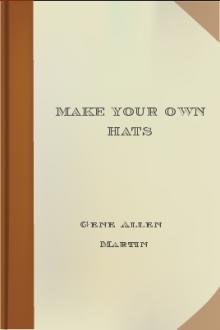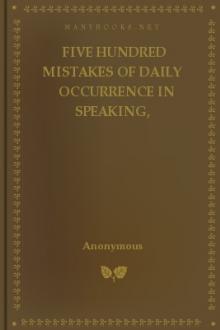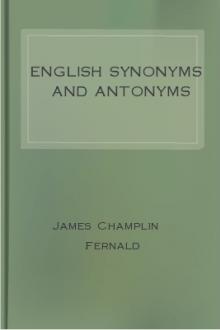Make Your Own Hats, Gene Allen Martin [ebook offline txt] 📗

- Author: Gene Allen Martin
- Performer: -
Book online «Make Your Own Hats, Gene Allen Martin [ebook offline txt] 📗». Author Gene Allen Martin
If the brim is rolling and is to be made flat, dampen it thoroughly, press it down flat on a smooth surface, and cover with weights; leave until dry, when a few coats of coloring may be applied. If the brim is separate from the crown, the hat may be completely changed by slipping the brim down over the crown, leaving it an inch or so from the bottom on one side or in the back, making a bandeau which lends itself to trimming of flowers, ribbons, or malines. In this case the bottom of the crown would require a wire sewed on at the edge to keep it in shape. If a high luster is desired, a coating of shellac may be applied the last thing before trimming.
Light straw hats—
Light straw hats may be cleaned by the use of soap and water or gasoline. If the hat is in need of bleaching, sulphur and water may be used, or a commercial bleaching fluid may be bought all ready to use according to printed directions. Two or three coatings of coloring will change the color. Pleasing results are sometimes obtained by using two different colors, one over the other. This, of course, requires experience and should be tried out before using on a hat.
When straw is to be re-sewed—
Rip carefully from the foundation; brush and press carefully. Some straw will not stand dampening, so try out a small piece first. Place it on a heavily-padded board and press on the wrong side.
Panama hats—
It is much more satisfactory to send a Panama to a good professional cleaner. A Panama hat may be made less severe-looking by the addition of an underfacing on the brim of some sheer material, such as georgette or crêpe de chine, finished off at the edge over a wire. The facing may be put on top of the brim if desired. The entire crown is sometimes changed by covering it with a figured chiffon drawn down tightly and finished at the bottom with a band and bow of ribbon.
Another change might be made by covering the entire crown with flower petals sewed down flat and intermingled with green leaves. They should then be covered with a layer or more of maline. This is a good way to use up old flowers. The flowers will stand a lot of retouching with color when they are veiled.
Old buckram frames—
When a covered buckram shape has become broken and out of shape, remove all the covering. Dampen the frame and press with a hot iron. A roll of cloth or paper must be held in the hand while pressing the crown. A break in buckram is difficult to remove; however, if new material is not available, much may be done with the old. Do not remove the headsize wire unless a pencil mark is made where it is to be sewed.
If the headsize wire is too large or too small, now is the time to change it. If the general shape of the brim is to be changed, remove the edge wire and trim to the required width. If it is to droop or roll, slash the brim from the outer edge to the headsize wire and lap one-quarter of an inch at the edge. Slash in several places if necessary. Sew close to both lapped edges of the buckram and cover with a strip of muslin or crinoline sewed on flat.
If a brim is to be made more flat or flaring, slash and add V-shaped pieces of buckram. If the headsize is entirely too large, this may be remedied by dividing the brim into halves. Remove the headsize wire and the edge wire, cutting through from front to back. Lap and sew; make the headsize wire the required size and sew back on the brim. Trim the outer edge of the brim and add the edge wire. The same thing may be done to the crown. If too large, divide into halves and lap the edges until it is the required size, or a piece of material may be added to make the crown larger. The crown may be lowered by cutting a piece from the base, or raised by adding a piece of heavy material at the base. When a fabric-covered brim is changed it will be found difficult to use the old covering, but it can sometimes be done.
Blocking over wire frames—
If a buckram frame needs changing radically, it may be done by blocking over a wire frame made for the purpose. The wire frame should have six sticks instead of four, and circles not more than one inch apart, shaped as desired. Old or new buckram, neteen, or any coarse material which has been heavily starched, may be used. Wet the fabric thoroughly with warm water.
Block the crown first. Place the material over the crown and pull it down until all the wrinkles are removed, pin closely to the headsize wire all around. When dry, mark with a pencil all around close to the headsize wire, remove from the frame, cut on the pencil mark and sew a headsize wire on the edge. If there are marks of the wire to be removed, hold a cloth on the inside of the crown and press lightly with a hot iron. The brim is managed in the same way. Mark at the headsize, cut off at this point one-half inch inside the mark, and sew a headsize wire on the pencil mark. Mark at the edge wire, cut off at the pencil mark, and finish with edge wire.
New brims for old crowns—
If the brim of a hat is past renewing, a new one may be made, or the wire brim from an old hat may be used with a crown of velvet, or any fabric or straw. The wire brim may be re-covered with georgette—an old, half-worn waist will do nicely, using the back or sleeves, or any portions that are not too badly worn. When a heavier crown is used, the edge of a sheer brim should have a fold of material like the crown sewed at the edge, or a row of straw when the crown is of straw braid.
Felt and beaver hats—
When soiled, clean with gasoline and cornmeal. To restore the gloss, rub the hat with a very fine piece of sandpaper which has been tacked over a small block of wood. Rub with the nap. To complete the process, remove the sandpaper and substitute a piece of velvet. Rub this on a hot iron, then on beeswax. Continue the operation of rubbing the hat with the nap until it is restored to its original freshness. The crown must be packed with cloth before rubbing to keep it solid enough to do satisfactory work. If the brim of a felt or beaver hat needs cutting down at the edge, mark with a piece of chalk where the brim is to be cut. Sew on this line with an unthreaded sewing machine several times, and the felt will be cut through and the edge broken off at this point. This looks much better than when cut with shears or with a knife.
Renovation of hat coverings and linings—
To freshen velvet and raise the pile, brush well to remove the dust. With the wrong side down, hold it over the spout of a tea-kettle of rapidly boiling water. An assistant is needed to brush it lightly as it is passed back and forth over the steam. The great force of the steam will raise the pile much more quickly than the method of using a damp cloth over a hot iron. If the velvet after steaming is found to be still too imperfect or faded to be used on the hat plain, it may be gathered a half inch apart or more and used either on the crown or the brim, or it may be mirrored by ironing on the right side with a hot iron, always ironing lightly one way, using a sweeping motion. Do not let the iron rest for a second on the material or it will leave a mark.
To freshen crêpe for mourning millinery—
Brush the crêpe with a fine brush to remove the dust. Clean in gasoline if necessary. Crêpe may be made to look like new if pinned down smoothly and evenly on a padded surface, a damp cloth placed over it, then a hot iron passed over it without touching it, but near enough so that a slight amount of steam will dampen the crêpe. Remove the cloth and allow the crêpe to dry in place. Crêpe becomes shabby-looking quickly if not given the best of care.
Cleaning, curling, and tinting feathers—
To clean, immerse the feather in gasoline to which has been added a few spoonfuls of cornmeal. Draw the feather through the hands several times until it is clean; rinse in clear gasoline and shake in the fresh air till dry. A very light-colored or white feather may be tinted by dissolving some oil paint in the gasoline used for rinsing.
To curl, draw the flues, a very few at a time, over a blunt knife. A plume is rather difficult to sew on a hat and produce the desired effect. The end of the quill may be sewed very firmly to the hat, while the tip of the plume should not be sewed close to the hat, otherwise it will look stiff.
Ribbons—
If soiled, they may be cleaned in gasoline or soap and water, using a brush. Do not rub or wring. Hang up to drip dry, or wind tightly around a bottle and leave to dry. Do not press until after twenty-four hours, if cleaned in gasoline. To produce extra stiffness, rinse in a weak solution of sugar and water. It is also very easy to change the color of ribbons by using any of the commercial cold dyes.
Flowers—
If flowers are faded, they may be touched up with water-color. If they are pink, rouge may be used effectively. If the edges are much frayed, trim them slightly with the shears. Green leaves may be dipped in hot paraffine to restore their gloss, or pressed with a warm iron without paraffine. Even very imperfect flowers may be made to look well if veiled with maline or georgette.
Quills—
Quills are sometimes improved by passing them between the thumb and finger on which a small amount of vaseline or oil has been placed. A quill may be curved by holding it over the spout of a tea-kettle of rapidly boiling water. Place a dull knife on the underside and press the quill hard enough to make a sharp dent. Do this every half inch. If the quill is sufficiently steamed this may be accomplished easily, and the result is permanent.
Wings—
Loose feathers should be glued in place and the wing covered with maline or a hair net of the same color. Wings may be covered with a coat of shellac which





Comments (0)